(PLAY VIDEO) The historical marker for Emma Guy Cromwell (#2167) is located at 122 West State St., Frankfort, Kentucky. The first woman in Kentucky elected to statewide office, Cromwell was elected Sec. of state in 1923. She held many political positions during a long career. Chosen state librarian in 1896 by legislature; was elected treasurer in 1927. Served as dir. of state parks, dir. of archives & state librarian. A political pioneer, Cromwell encouraged women to follow her in “bla[ing] a trail for a new day for women when they can stand side by side with men in governing our great country.” She called Simpson, Allen, and Warren counties “home” but lived her adult life in Frankfort, where she died, July 19,1952. READ MORE AND SEE A MAP LOCATING THE EMMA GUY CROMWELL MARKER.
(PLAY VIDEO) The historical marker for Mary Elliott Flanery (#2136) is located at 2716 Panola St. in Catlettsburg, Kentucky. The first woman elected to Kentucky legislature, 1921. Mary E. Flanery elected to House of Representatives from Boyd County. She had worked for woman suffrage; was concerned with marriage and divorce laws and educational reform. At her death, 1933, a bronze marker was placed at her seat, No. 40, in house chamber. See over. Presented by The Democratic Woman’s Club of Ky. Mary Elliott Flanery – Mary E. Flanery was a journalist, suffragist, and politician. Born 1867 in Carter Co. (now Elliott Co.), she wrote for Ashland Daily Independent, 1904-26; also taught in Elliott and Carter counties. Chosen in 1924 as delegate to the Democratic National Convention, New York City. In addition to public life, she and her husband reared five children. Buried at Ashland Cemetery.
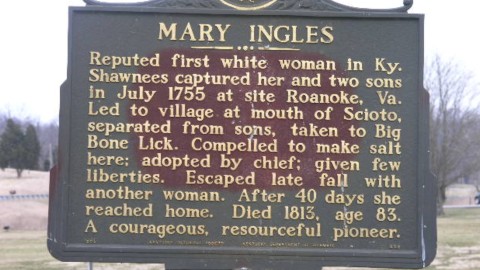 The historical marker for Mary Ingles (#163) is located at Silver Grove, KY 8 at Oak St. in Campbell County, Kentucky. Said to have been first white woman in Kentucky. Captured by Indians in Virginia, July 1755, and taken to Ohio. Later she escaped a salt-making party at Big Bone Lick and made her way across the Kentucky wilderness back to Virginia.
The historical marker for Mary Ingles (#163) is located at Silver Grove, KY 8 at Oak St. in Campbell County, Kentucky. Said to have been first white woman in Kentucky. Captured by Indians in Virginia, July 1755, and taken to Ohio. Later she escaped a salt-making party at Big Bone Lick and made her way across the Kentucky wilderness back to Virginia.
(PLAY VIDEO) The historical marker for Anna Mac Clarke (#1970) is located on the courthouse lawn in Lawrenceburg, Kentucky. This Lawrenceburg native was one of the first black women in Kentucky to enlist during World War II. She joined Women’s Army Auxiliary Corps in 1942, and was commissioned a 1st Lieutenant the next year in newly named Women’s Army Corps. While stationed at Douglas Air Field, Arizona, she led fight to desegregate base theater. Presented by Kentucky African American Heritage Commission. Anna Mac Clarke (1919-44) – A 1937 graduate of Lawrenceburg’s Colored High School, Clarke earned B.A. from Ky. State College. After army enlistment, she became only African American in 15th Officer Training Class at Ft. Des Moines, Iowa. In 1943, she was first black WAAC assigned to duty with an all-white company as platoon commander (4th Co., 3rd Regt.). Buried Woodlawn Hills Cem., Stringtown.
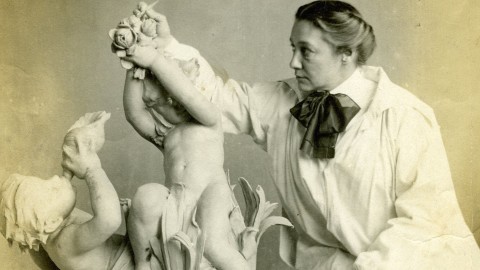 The historical marker for Enid Yandell (#2133) is located at Jct. 2100 Eastern Parkway & 1400 Cherokee Rd., Louisville, Kentucky. Challenged the role of women in the art world as a renowned sculptor. Born 1869 in Louisville and graduated Cinn. Art Acad. in 1889. Gained prominence sculpting caryatids for Woman’s Building at 1893 World’s Columbian Exposition in Chicago. In 1897, the Tennessee Centennial Exposition chose her to sculpt a 25′ Athena in Nashville. Presented by Ky. Foundation for Women and Enid: Generations of Women Sculptors. Renowned Woman Sculptor – Enid Yandell established studios in N.Y. and Paris. Studied with Rodin and MacMonnies. Inducted into National Sculpture Society in 1899 as one of first women members. She founded Branstock summer art school in Edgartown, Mass. Two noted works in Louisville: Daniel Boone Monument and Hogan’s Fountain. Buried in Cave Hill Cem. Presented by the families of David Yandell Wood and Ian Yandell Henderson.
The historical marker for Enid Yandell (#2133) is located at Jct. 2100 Eastern Parkway & 1400 Cherokee Rd., Louisville, Kentucky. Challenged the role of women in the art world as a renowned sculptor. Born 1869 in Louisville and graduated Cinn. Art Acad. in 1889. Gained prominence sculpting caryatids for Woman’s Building at 1893 World’s Columbian Exposition in Chicago. In 1897, the Tennessee Centennial Exposition chose her to sculpt a 25′ Athena in Nashville. Presented by Ky. Foundation for Women and Enid: Generations of Women Sculptors. Renowned Woman Sculptor – Enid Yandell established studios in N.Y. and Paris. Studied with Rodin and MacMonnies. Inducted into National Sculpture Society in 1899 as one of first women members. She founded Branstock summer art school in Edgartown, Mass. Two noted works in Louisville: Daniel Boone Monument and Hogan’s Fountain. Buried in Cave Hill Cem. Presented by the families of David Yandell Wood and Ian Yandell Henderson.
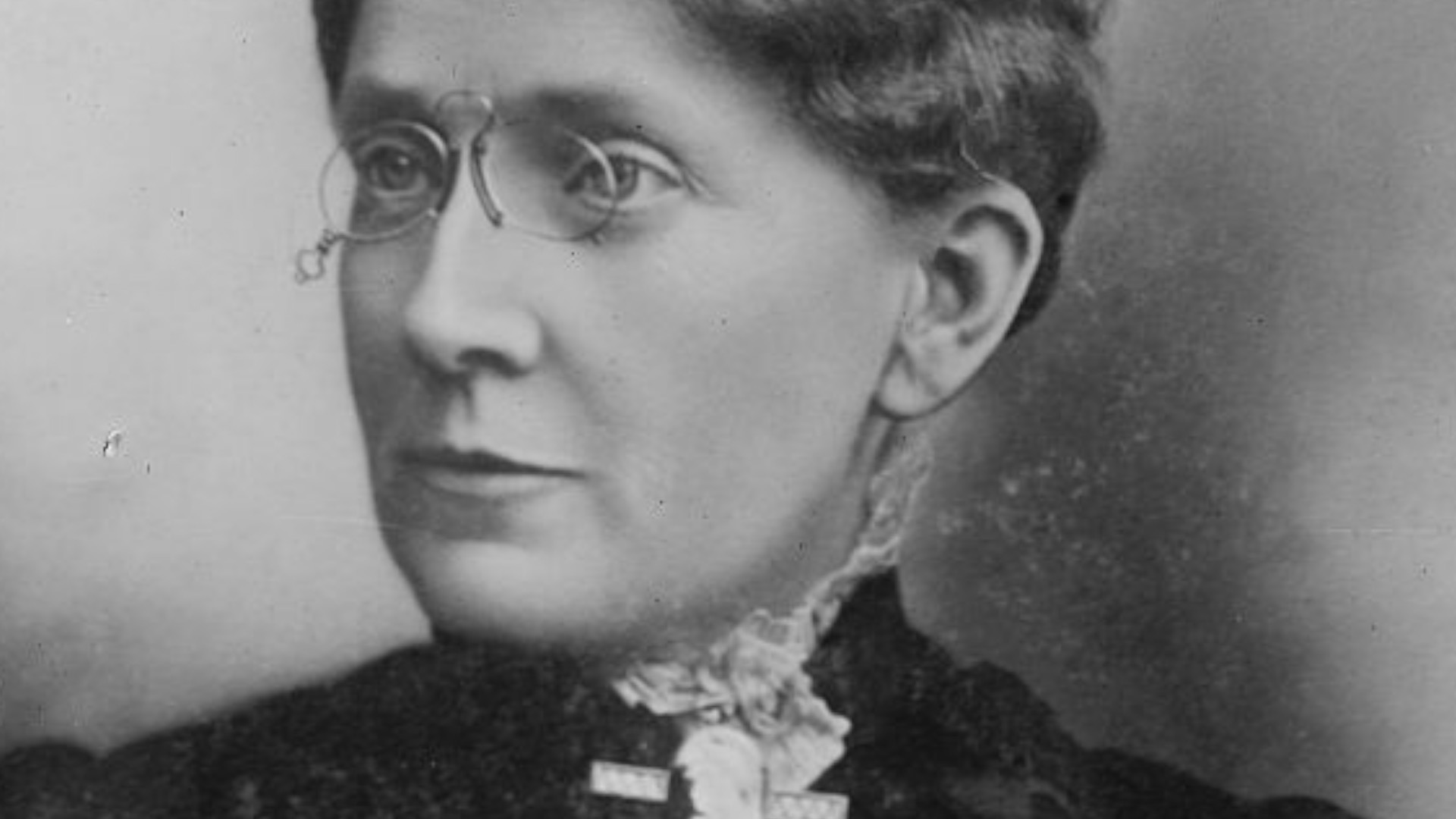 Historical Marker #1872 in Richmond at Big Hill Avenue recognizes the work of Frances E. Beauchamp, an advocate for prohibition. This Madison Co. native spearheaded the antiliquor crusade in Ky. and was a leading figure in temperance movement nationwide. A protegee of famed Frances E. Willard, Beauchamp lectured on dry cause throughout the country. Among other causes she championed were prison reform and woman suffrage. Prohibition Advocate – Frances Beauchamp was preeminent leader of dry cause in Kentucky. Pres. of Ky. Women’s Christian Temperance Union from 1895 until her death in 1923. She served ten years as chairman of state Prohibition party at a time when women were denied the vote. Largely through Beauchamp’s efforts, a prohibition amendment to Kentucky constitution was adopted in 1919. READ MORE & SEE A MAP LOCATING THE MARKER OF FRANCES E. BEAUCHAMP.
Historical Marker #1872 in Richmond at Big Hill Avenue recognizes the work of Frances E. Beauchamp, an advocate for prohibition. This Madison Co. native spearheaded the antiliquor crusade in Ky. and was a leading figure in temperance movement nationwide. A protegee of famed Frances E. Willard, Beauchamp lectured on dry cause throughout the country. Among other causes she championed were prison reform and woman suffrage. Prohibition Advocate – Frances Beauchamp was preeminent leader of dry cause in Kentucky. Pres. of Ky. Women’s Christian Temperance Union from 1895 until her death in 1923. She served ten years as chairman of state Prohibition party at a time when women were denied the vote. Largely through Beauchamp’s efforts, a prohibition amendment to Kentucky constitution was adopted in 1919. READ MORE & SEE A MAP LOCATING THE MARKER OF FRANCES E. BEAUCHAMP.
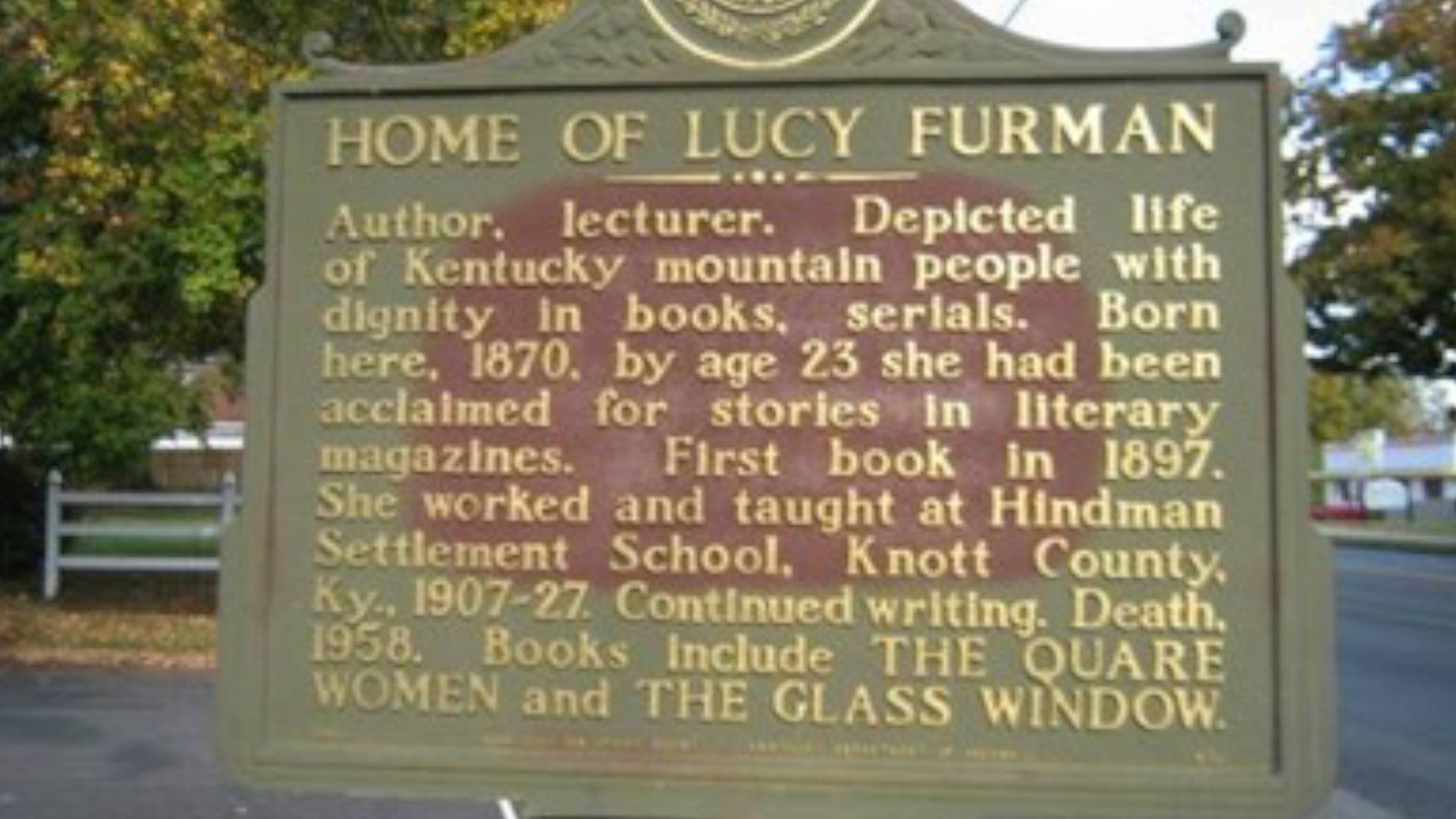 The historical marker for Lucy Furman (#870) is located at Powell Street, Henderson, Kentucky US 41. Author, lecturer, Lucy Furman depicted life of Kentucky mountain people with dignity in books, serials. Born 1870, by age 23 she had been acclaimed for stories in literary magazines. First book in 1897. She worked and taught at Hindman Settlement School, Knott County, Ky., 1907-27. Continued writing. Death, 1958. Books include The Quare Women and The Glass Window.
The historical marker for Lucy Furman (#870) is located at Powell Street, Henderson, Kentucky US 41. Author, lecturer, Lucy Furman depicted life of Kentucky mountain people with dignity in books, serials. Born 1870, by age 23 she had been acclaimed for stories in literary magazines. First book in 1897. She worked and taught at Hindman Settlement School, Knott County, Ky., 1907-27. Continued writing. Death, 1958. Books include The Quare Women and The Glass Window.
 The historical marker for Jennie C. Benedict (#2142) is located west side of 4th St. between Chestnut and Muhammad Ali, Louisville. Noted chef, caterer, and author was born 1860 in Louisville. She began her career in 1893 and in 1900 opened Benedict’s restaurant and tearoom on South 4th Street. Entrepreneur Benedict was invited to join Louisville Board of Trade, 1903. Best known as creator of “benedictine,” a sandwich spread that remains a Kentucky food specialty. A founder of Louisville’s Business Women’s Club by 1899; published Blue Ribbon Cookbook 1902. As social reformer for women and the poor, Benedict collaborated with Jennie Casseday in founding King’s Daughters & Sons Training School for Nurses at City Hospital; and an infirmary for women.
The historical marker for Jennie C. Benedict (#2142) is located west side of 4th St. between Chestnut and Muhammad Ali, Louisville. Noted chef, caterer, and author was born 1860 in Louisville. She began her career in 1893 and in 1900 opened Benedict’s restaurant and tearoom on South 4th Street. Entrepreneur Benedict was invited to join Louisville Board of Trade, 1903. Best known as creator of “benedictine,” a sandwich spread that remains a Kentucky food specialty. A founder of Louisville’s Business Women’s Club by 1899; published Blue Ribbon Cookbook 1902. As social reformer for women and the poor, Benedict collaborated with Jennie Casseday in founding King’s Daughters & Sons Training School for Nurses at City Hospital; and an infirmary for women.
(PLAY VIDEO) The historical marker for Laura Clay (#1800) is located 9 miles north of Richmond at White Hall, off US 25. Woman’s rights leader, born here, was pres. of Kentucky Equal Rights Association (1888-1912). Daughter of Cassius Marcellus Clay, Laura won coeducational, property, and joint guardianship rights for Kentucky women and held key positions in National American Woman Suffrage Association. Her associates included Susan B. Anthony. Woman suffrage gained by 19th Amendment, 1920. Laura Clay is buried in Lexington. READ MORE & SEE A MAP LOCATING THE LAURA CLAY MARKER.
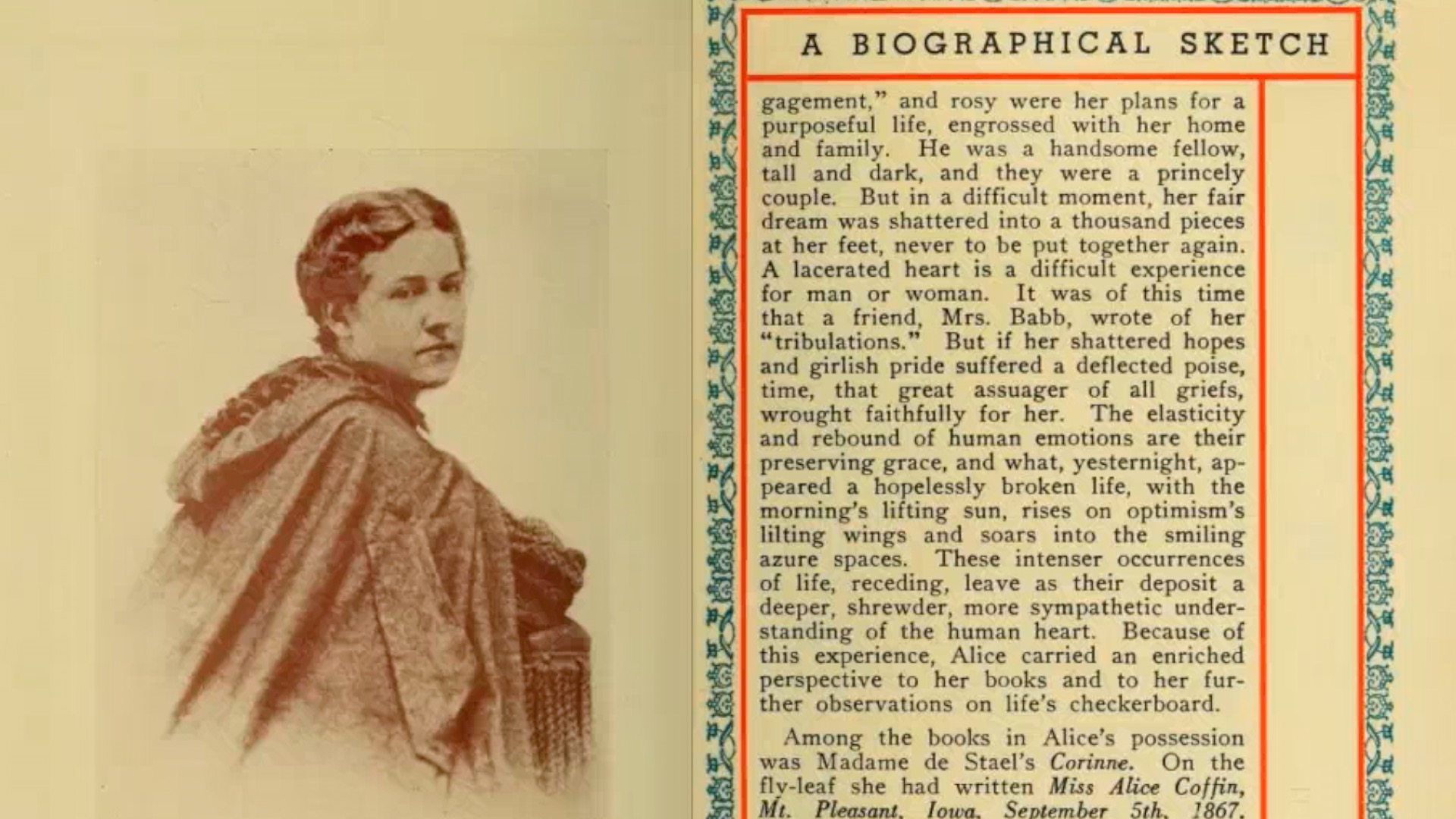 Born on Jefferson Street in Louisville, Alice Virginia Coffin was one of seven founders of P.E.O., an international philanthropic and educational organization for women. It began as a sorority at the Iowa Wesleyan College, 1869; owns Cottey College in Missouri, and provides monetary assistance for education of women. Miss Coffin designed the P.E.O. seal. Presented by Ky. P.E.O. Chapters. The house is located on Jefferson St., between Preston & Floyd Streets in Louisville. Click here to see a biographical sketch about Ms. Coffin published in 1940.
Born on Jefferson Street in Louisville, Alice Virginia Coffin was one of seven founders of P.E.O., an international philanthropic and educational organization for women. It began as a sorority at the Iowa Wesleyan College, 1869; owns Cottey College in Missouri, and provides monetary assistance for education of women. Miss Coffin designed the P.E.O. seal. Presented by Ky. P.E.O. Chapters. The house is located on Jefferson St., between Preston & Floyd Streets in Louisville. Click here to see a biographical sketch about Ms. Coffin published in 1940.
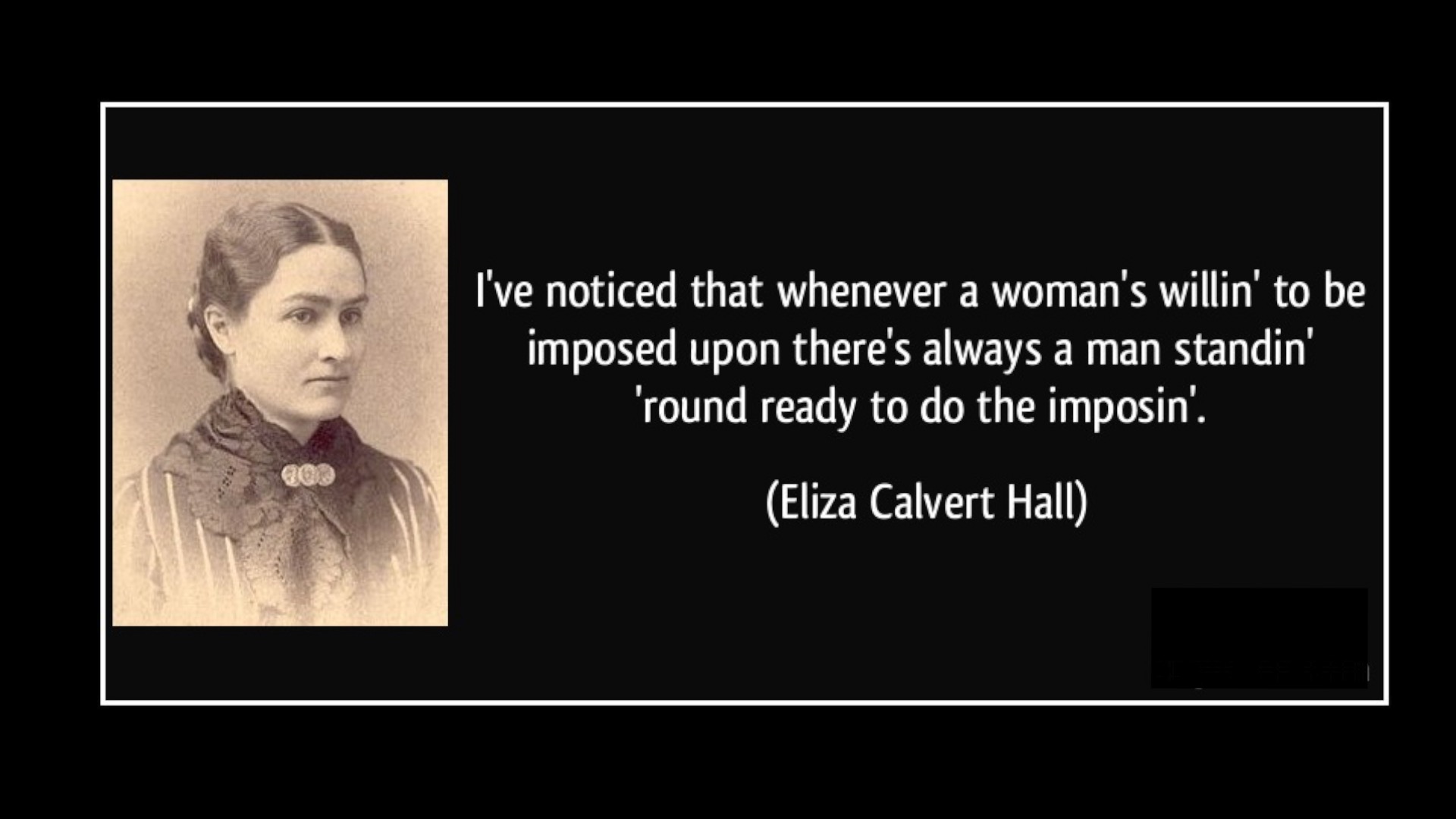 Lida Calvert Obenchain (“Eliza Calvert Hall”), suffragist, press superintendent of Kentucky. Equal Rights Association, poet, author. Her most famous story, “Sally Ann’s Experience” (1898), protested women’s inequality. President Roosevelt praised her first collection of stories, Aunt Jane of Kentucky(1907). Royalties helped purchase home at 1353 Chestnut St. The Land of Long Ago (1909), To Love and to Cherish (1911) and Clover and Blue Grass (1916) followed. For A Book of Hand-Woven Coverlets (1912), she bought coverlets from wagons of tobacco farmers on Chestnut St. Her books reached at least one million readers. The historicall marker is located at the corner of Chestnet & 14th Streets in Bowling Green. READ MORE AND SEE A MAP LOCATING THE ELIZA CALVERT HALL MARKER.
Lida Calvert Obenchain (“Eliza Calvert Hall”), suffragist, press superintendent of Kentucky. Equal Rights Association, poet, author. Her most famous story, “Sally Ann’s Experience” (1898), protested women’s inequality. President Roosevelt praised her first collection of stories, Aunt Jane of Kentucky(1907). Royalties helped purchase home at 1353 Chestnut St. The Land of Long Ago (1909), To Love and to Cherish (1911) and Clover and Blue Grass (1916) followed. For A Book of Hand-Woven Coverlets (1912), she bought coverlets from wagons of tobacco farmers on Chestnut St. Her books reached at least one million readers. The historicall marker is located at the corner of Chestnet & 14th Streets in Bowling Green. READ MORE AND SEE A MAP LOCATING THE ELIZA CALVERT HALL MARKER.
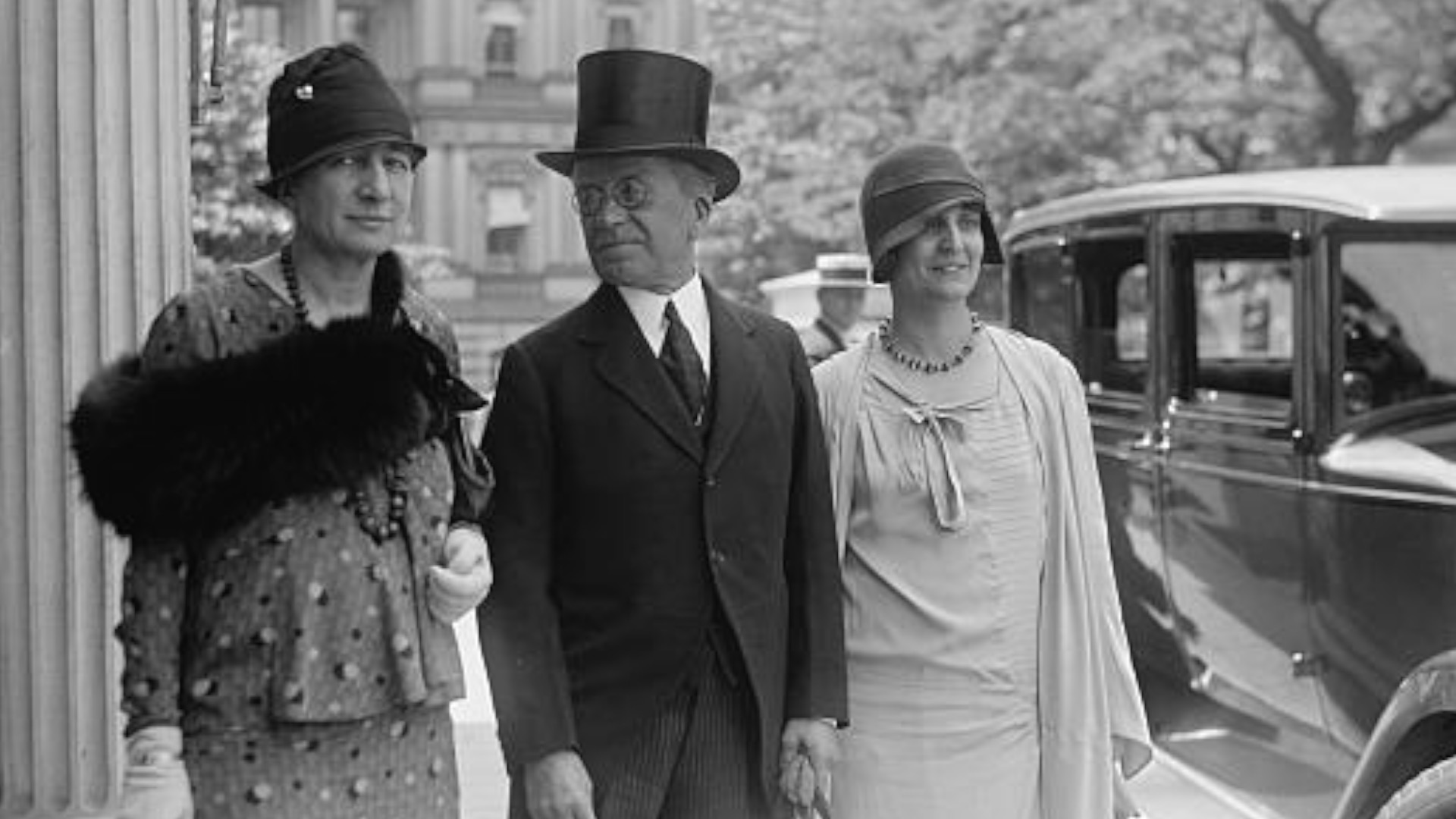 Dr. Lena Madesin Phillips (above left), founder of National Federation of Business and Professional Women’s Clubs, 1919, born here on 303 S. Main Street, Nicholasville, September 15, 1881. Her work with the YWCA, 1917, led to interest in organization of business women. Instrumental in organizing and first President of the International Federation of B. and P. W., 1930. Died 1955; buried Maple Grove Cem., Nicholasville. This marker is located at 303 S Main. Street, Nicholasville.
Dr. Lena Madesin Phillips (above left), founder of National Federation of Business and Professional Women’s Clubs, 1919, born here on 303 S. Main Street, Nicholasville, September 15, 1881. Her work with the YWCA, 1917, led to interest in organization of business women. Instrumental in organizing and first President of the International Federation of B. and P. W., 1930. Died 1955; buried Maple Grove Cem., Nicholasville. This marker is located at 303 S Main. Street, Nicholasville.
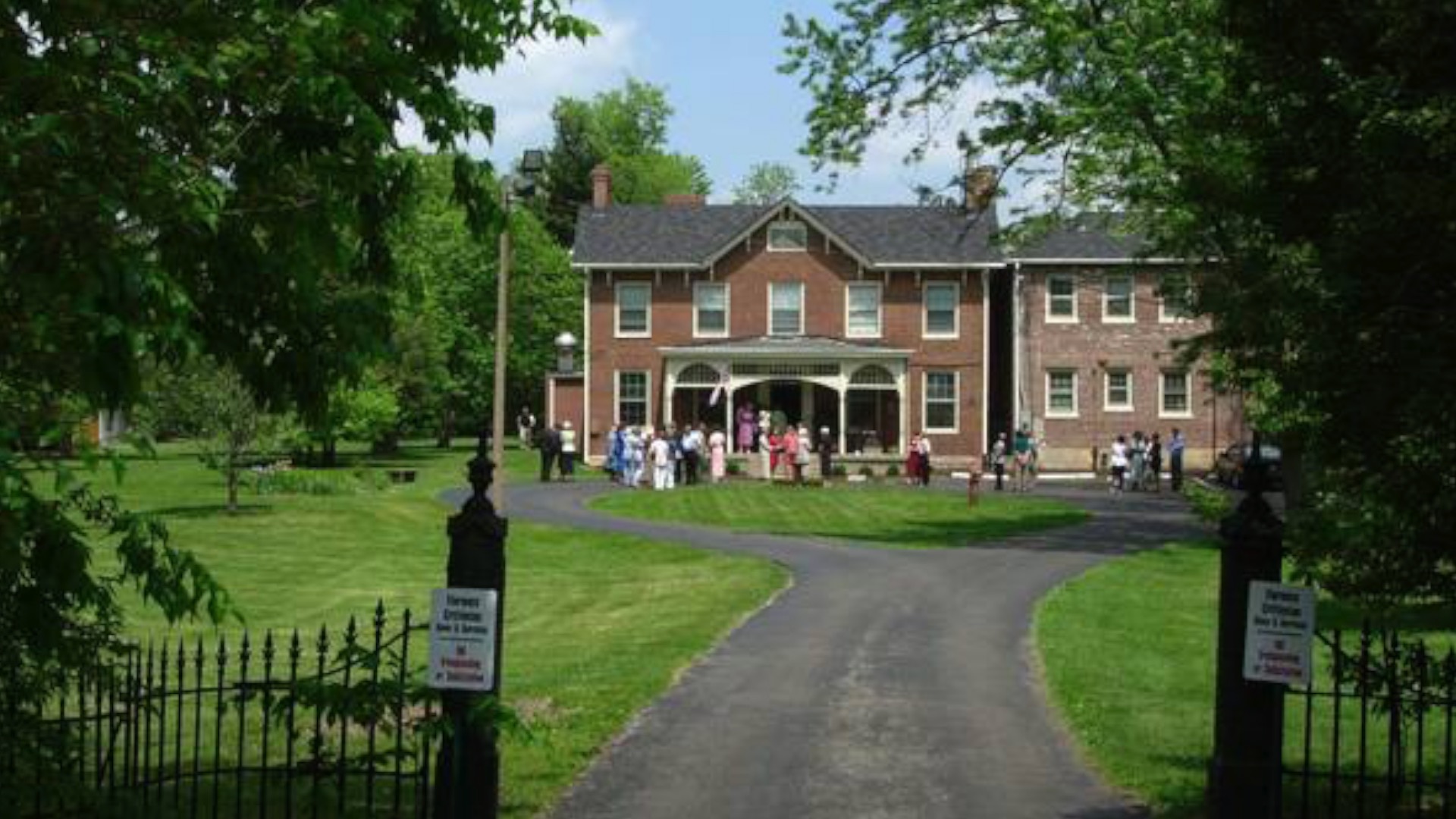 In 1894, a group of local women established the House of Mercy on this site to provide a home for single pregnant women. In 1921 the home became affiliated with Florence Crittenton Homes, founded by Charles Crittenton in memory of his daughter, Florence, for the purpose of helping women in need. For 118 years, the Florence Crittenton Home helped countless women and girls. Essential social & medical services were provided, with aid from staff, donors, volunteers, schools, churches, hospitals, and government funding. The home closed in 2013. The historical marker is located at 519 W. 4th St., Lexington.
In 1894, a group of local women established the House of Mercy on this site to provide a home for single pregnant women. In 1921 the home became affiliated with Florence Crittenton Homes, founded by Charles Crittenton in memory of his daughter, Florence, for the purpose of helping women in need. For 118 years, the Florence Crittenton Home helped countless women and girls. Essential social & medical services were provided, with aid from staff, donors, volunteers, schools, churches, hospitals, and government funding. The home closed in 2013. The historical marker is located at 519 W. 4th St., Lexington.
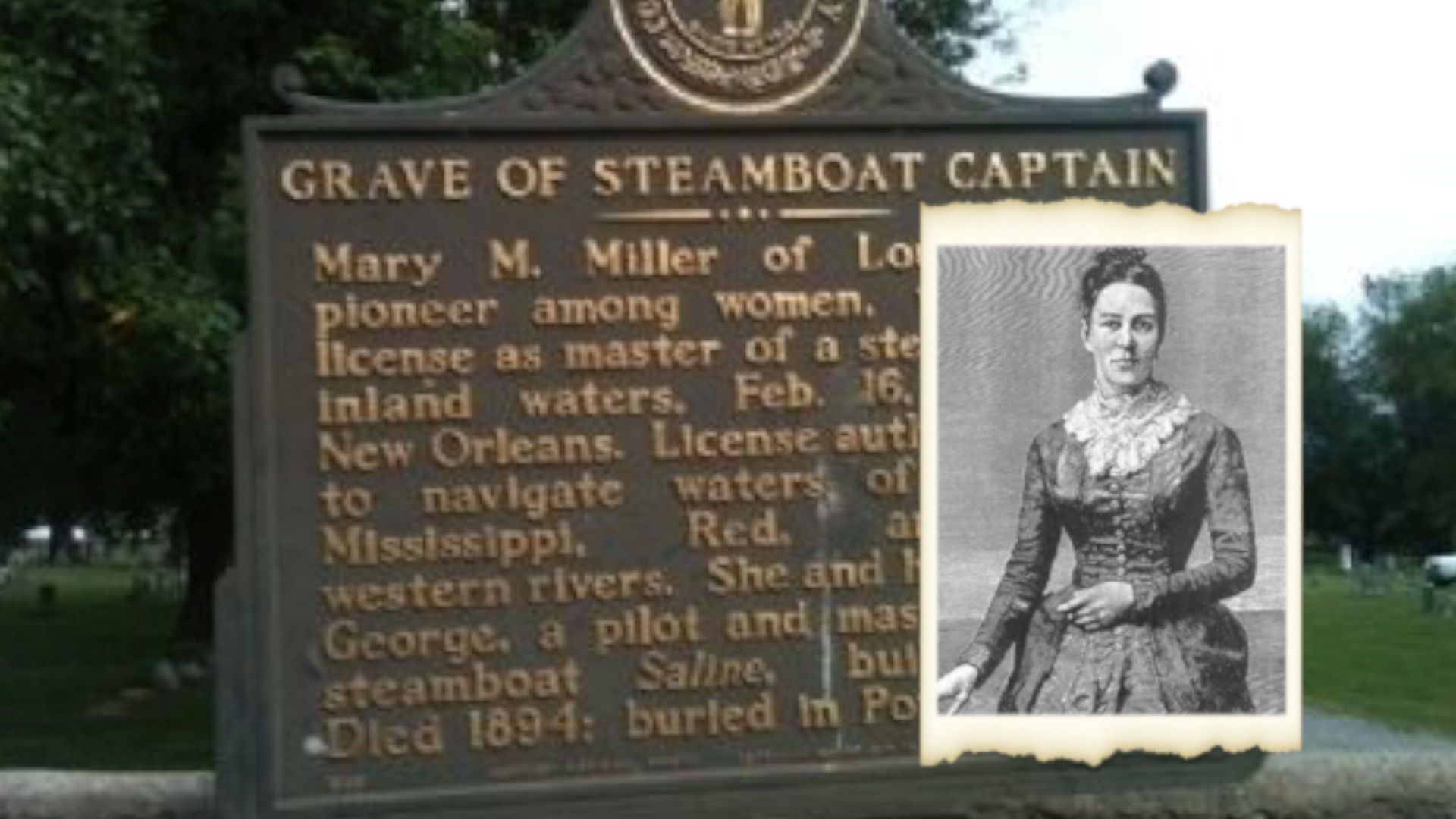 Mary Millicent Miller of Louisville, a pioneer among women, was issued license as master of a steamboat on inland waters, Feb. 16, 1884, in New Orleans. License authorized her to navigate waters of Quachita, Mississippi, Red, and other western rivers. She and her husband George, a pilot and master, owned steamboat SALINE, built nearby. Died 1894; buried in Portland Cemetery. This marker is located at Bank St. at the entrance to Portland Cemetery in Louisville
Mary Millicent Miller of Louisville, a pioneer among women, was issued license as master of a steamboat on inland waters, Feb. 16, 1884, in New Orleans. License authorized her to navigate waters of Quachita, Mississippi, Red, and other western rivers. She and her husband George, a pilot and master, owned steamboat SALINE, built nearby. Died 1894; buried in Portland Cemetery. This marker is located at Bank St. at the entrance to Portland Cemetery in Louisville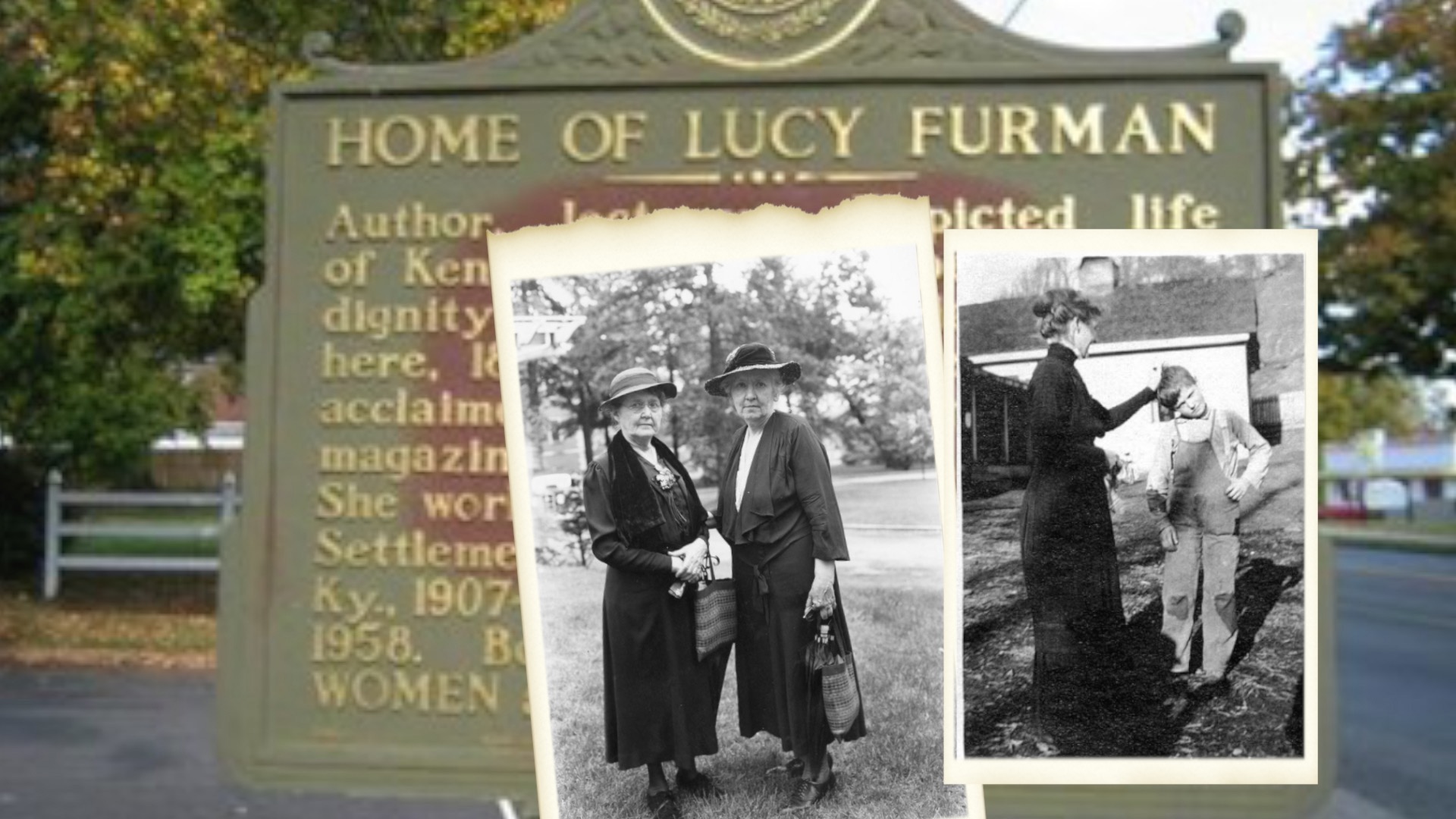 Author, lecturer, Lucy Furman depicted life of Kentucky mountain people with dignity in books, serials. Born here, 1870, by age 23 she had been acclaimed for stories in literary magazines. First book in 1897. She worked and taught at Hindman Settlement School, Knott County, Ky., 1907-27. She continued to write. She died in 1958. Her books include The Quare Women and The Glass Window. The historical marker is located at Powell Street, Henderson, US 41
Author, lecturer, Lucy Furman depicted life of Kentucky mountain people with dignity in books, serials. Born here, 1870, by age 23 she had been acclaimed for stories in literary magazines. First book in 1897. She worked and taught at Hindman Settlement School, Knott County, Ky., 1907-27. She continued to write. She died in 1958. Her books include The Quare Women and The Glass Window. The historical marker is located at Powell Street, Henderson, US 41(PLAY VIDEO) Thelma Stovall – Political Life, written by Amy Roe. Historical Marker #2170 in Shelby County recognizes the political achievements of Thelma Stovall, who became the first woman to be elected lieutenant governor of Kentucky in 1975. Stovall was a female pioneer in southern politics. She began her long career serving in the Kentucky House of Representatives, where she served three terms. She was elected secretary of state in 1956, 1964, and 1972, and served as state treasurer in 1960 and 1968. She held those two offices continuously for five consecutive terms, from 1956 to 1975. This practice was known at the time as “musical chairs” office holding, since Kentucky’s constitution prohibited any statewide official from serving consecutive terms in the same office. As secretary of state, Stovall held the third-ranking political office in Kentucky. In 1959, she took advantage of this position while the governor and lieutenant governor were both out of state. NOTE: There are two markers for Thelma Stovall with one representing her political life and another representing her personal life.
READ MORE ABOUT THELMA’S POLITICAL LIFE AND SEE A MAP LOCATING THIS MARKER AT THIS LINK.
READ MORE ABOUT THELMA’S PERSONAL LIFE AND LOCATE THAT MARKER AT THIS LINK.